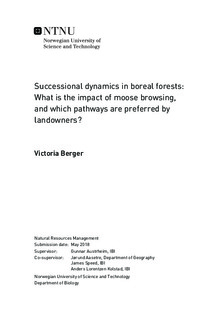Successional dynamics in boreal forests: What is the impact of moose browsing, and which pathways are preferred by landowners?
Master thesis
Permanent lenke
http://hdl.handle.net/11250/2504710Utgivelsesdato
2018Metadata
Vis full innførselSamlinger
- Institutt for biologi [2512]
Sammendrag
Norwegian boreal forests are usually managed for timber production, but also provide other ecosystem services, including game meat, income from hunting licenses, and recreational opportunities. Forest landowners values and objectives can influence management decisions, and hence the future of Norwegian forests and their potential for multi-use. High moose (Alces alces) densities have the potential to impact plant communities, and their influence can be profound. Therefore, ecosystem services can be affected, which presents challenges to forest management. The objectives of this study are to examine the effect of moose exclusion (n = 16) on the regeneration of boreal trees after clear-cutting, as well as landowners perspectives (n = 12 interviews) on forest ecosystem management in southeastern Norway. Moose exclusion markedly increased the growth of deciduous trees (Betula spp. and Sorbus aucuparia). Of the economically important conifer species, Scots pine (Pinus sylvestris) was positively affected and Norway spruce (Picea abies) was not affected by the exclosures. A broad range of ecosystem services were recognized by landowners, who held a diverse set of forest values. However, landowners overall management objective was timber production, which corresponds with their visions of future forest use, associating forestry with climate mitigation and energy transition. As moose is a source of disturbance and a valuable resource, it is essential to find a density that is socio-economically viable that fits within ecological bounds. Landowners perspectives can be important knowledge for developing sustainable forest management systems and policies balancing moose, timber, biodiversity, and other services important for human well-being.
